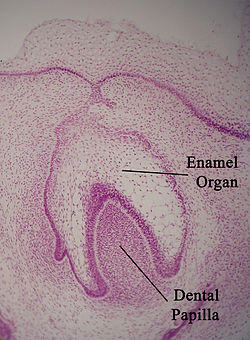| Enamel organ | |
|---|---|
 Enamel organ | |
| Details | |
| Identifiers | |
| Latin | organum enameleum |
| MeSH | D004658 |
| TE | organ_by_E5.4.1.1.2.3.5 E5.4.1.1.2.3.5 |
| Anatomical terminology | |
The enamel organ, also known as the dental organ, is a cellular aggregation seen in a developing tooth and it lies above the dental papilla.[1] The enamel organ which is differentiated from the primitive oral epithelium lining the stomodeum. The enamel organ is responsible for the formation of enamel, initiation of dentine formation, establishment of the shape of a tooth's crown, and establishment of the dentoenamel junction.[1]
The enamel organ has four layers; the inner enamel epithelium, outer enamel epithelium, stratum intermedium, and the stellate reticulum.[1]
The dental papilla, the differentiated ectomesenchyme deep to the enamel organ, will produce dentin and the dental pulp. The surrounding ectomesenchyme tissue, the dental follicle, is the primitive cementum, periodontal ligament and alveolar bone beneath the tooth root.[1] The site where the internal enamel epithelium and external enamel epithelium coalesce is the cervical root, important in proliferation of the dental root.[1]